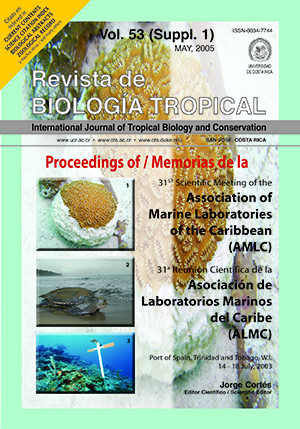Abstract
The Godineau (South Oropuche) Swamp (3171 ha) on the southwestern coast of Trinidad (10º13- 15’N, 61º30-32’W) is heavily impacted by anthropogenic activities including fishing, oil exploration, drainage manipulation and wetland clearance. To reduce the negative effects of these activities and to manage the swamp more sustainably, more quantitative information is needed on the ecology of the wetland and the activities that occur within it. This study focuses on the distribution of the fish resources and exploited fisheries as a basis for more informed management directives. Sampling was conducted during 2002, in April-May (for dry season) and July-September (for wet season sampling). Ichthyofauna was sampled both day and night using trammel nets and a push seine. Fishing activities were assessed using a questionnaire and informal discussions with fishers. The wetland supports over 29 species of fish distributed over the freshwater, estuarine and saline zones (n=1454). Species distribution is seasonal, with evidence of the wetland being used as a spawning ground. Species richness and species diversity (Shannon-Weiner Index) for the wetland ranged over 2-11 and 0.162-0.967, respectively, in the dry season and 2-7 and 0.036-0.903, respectively, in the wet season. Communities inhabiting the saline and estuarine zones of the wetland were dominated by a single species, Hexanematichthys bonillai. Percent Similarity Indices were 41.8% for freshwater, 72.7% for estuarine and 79.8% for estuarine-saline communities. The commercial species accounted for 18% of total catch sampled and consisted of Centropomus undecimalis, Megalops atlanticus, Hoplosternum littorale, Hoplias malabaricus, Ophioscion punctatissimus and Macrodon ancyclodon. Full-time and part-time fishers, including recreational fishers, accounted for 14.3% and 85.7%, respectively of all fishers surveyed (n=56). A conservative estimate of the revenue earned directly at point of sale for fish and shellfish, is approximately US$43 000 per annum. Fishing is important in the area. Management directives taking into account the ecology of the target organisms are needed to allow these fishing practices to be continued in a sustainable manner.References
Alleng, G.P. 1997. Coastal wetlands in Trinidad and Tobago: Status and trends research report. Institute of Marine Affairs, Chaguaramas, Trinidad. 59 p.
Anonymous. 1979. Development of the Oropuche area- pre-feasibility study funded by the European Development Fund- Technical report including appendices and maps. SCET Agri International. Portof- Spain, Trinidad. 164 p.
Anonymous. 1999. Fourth progress report on the environmental monitoring program for the 6th sampling period of benthic, marine water and sediment quality and at the construction outfalls at the LNG production plant, Point Fortin, Trinidad. Institute of Marine Affairs (IMA). Document prepared for Atlantic LNG Company of Trinidad and Tobago. 181 p.
Anonymous. 2001. Report on the Investigation of an Oil Spill in the Oropuche River, South Oropuche Swamp, Trinidad. Environmental Incident Report. Institute of Marine Affairs (IMA), Trinidad. 24 p.
Begon, M., J.L. Harper & C.R. Townsend. 1996. Ecology: Individuals, Populations and Communities, 3rd Ed. Blackwell Science, London. 1068 p.
Berkes, F., R. Mahon, P. McConney, R. Pollnac & R.S. Pomeroy. 2001. Managing small-scale fisheries: Alternative directions and methods. International Development Research Centre, Ottowa, Canada. 320 p.
Boodoosingh, M. 1992. A review of possible impacts of human activities on fisheries in the coastal waters of Trinidad, with emphasis on the Gulf of Paria. Fisheries Division, Ministry of Agriculture, Land and Marine Resources, Port-of-Spain, Trinidad. 125 p.
Brower, J.E., J.H. Zar & C.N von Ende. 1990. Field and Laboratory Methods for General Ecology. 3rd Ed. W.C. Brown Publ., Dubuque, Iowa. 237 p.
Clark, J.R. 1992. Integrated management of coastal zone. FAO Fisheries Technical Paper 327. FAO, Rome, Italy. 167 p.
Fischer, W. 1978. FAO species identification sheets for fishery purposes: Western Central Atlantic (Fishing area 31), Vol. II. Food and Agriculture Organization, Rome, Italy.
Itakura, K. 1974. The profile of rice and Oropuche Project. Ministry of Agriculture, Field Engineering, Trinidad and Tobago. 47 p.
James, C. 1990. Wetlands in Trinidad and Tobago. National report for Trinidad and Tobago. 5th Caribbean Foresters’ Conference May 22-25, 1990, Port-of- Spain, Trinidad. 35 p.
James, C., N. Nathai-Gyan & G. Hislop. 1986. Trinidad and Tobago, p. 256-265. In D.A. Scott & M. Carbonell (eds.). A Directory of Neotropical Wetlands: IUCN Concerv. Monitoring Centre, Cambridge, UK.
Kumarsingh K., L.A. Hall & A.M. Siung-Chang. 1996. Spatial and temporal variations of particulate and sediment organic matter on a shallow, tropical, estuarine bank off Trinidad, West Indies. Carib. Mar. Stud. 44: 1-13.
Neilsen, L.A. & D.L. Johnson (eds.). 1983. Fisheries Techniques. South. Print. Comp., Virginia. 468 p.
Rajkumar, G. 2001. A natural resource damage assessment of a contaminated site in the Godineau Swamp, Trinidad. M.Sc. Thesis, Univ. West Indies, Cave Hill, Barbados. 84 p.
Rakocinski, C.F., B.H. Comyns, M.S. Peterson & G.A. Zapfe. 2000. Field growth responses of juvenile white trout (Cynoscion arenarius) to continuous variation in physical habitat conditions. 53rd Ann. Gulf Carib. Fish. Inst., Biloxi, Mississippi. 13 p.
Ramcharan, E.K., G. deSouza & R. French. 1982. Technical report: Inventory of the living resources of coastal wetlands in Trinidad. Institute of Marine Affairs, Chaguaramas, Trinidad. 212 p.
Ramnarine, I.W. 1997. Report on the fisheries ecology of the Caroni swamp. Consultants Report to the Inter American Development Bank, Port-of-Spain, Trinidad. 74 p.
Thurston, R.V. & P.C. Gehrke. 1992. OXYREF (Oxygen Requirements for Fish) a datafile of test results reported in the literature on the respiratory oxygen requirements of fishes. Montana State University, Montana. (Downloaded: October 25, 2004, http://www.epa. gov/ceampubl/swater/oxyref/USERMANU.PDF).
Comments

This work is licensed under a Creative Commons Attribution 4.0 International License.
Copyright (c) 2005 Revista de Biología Tropical






